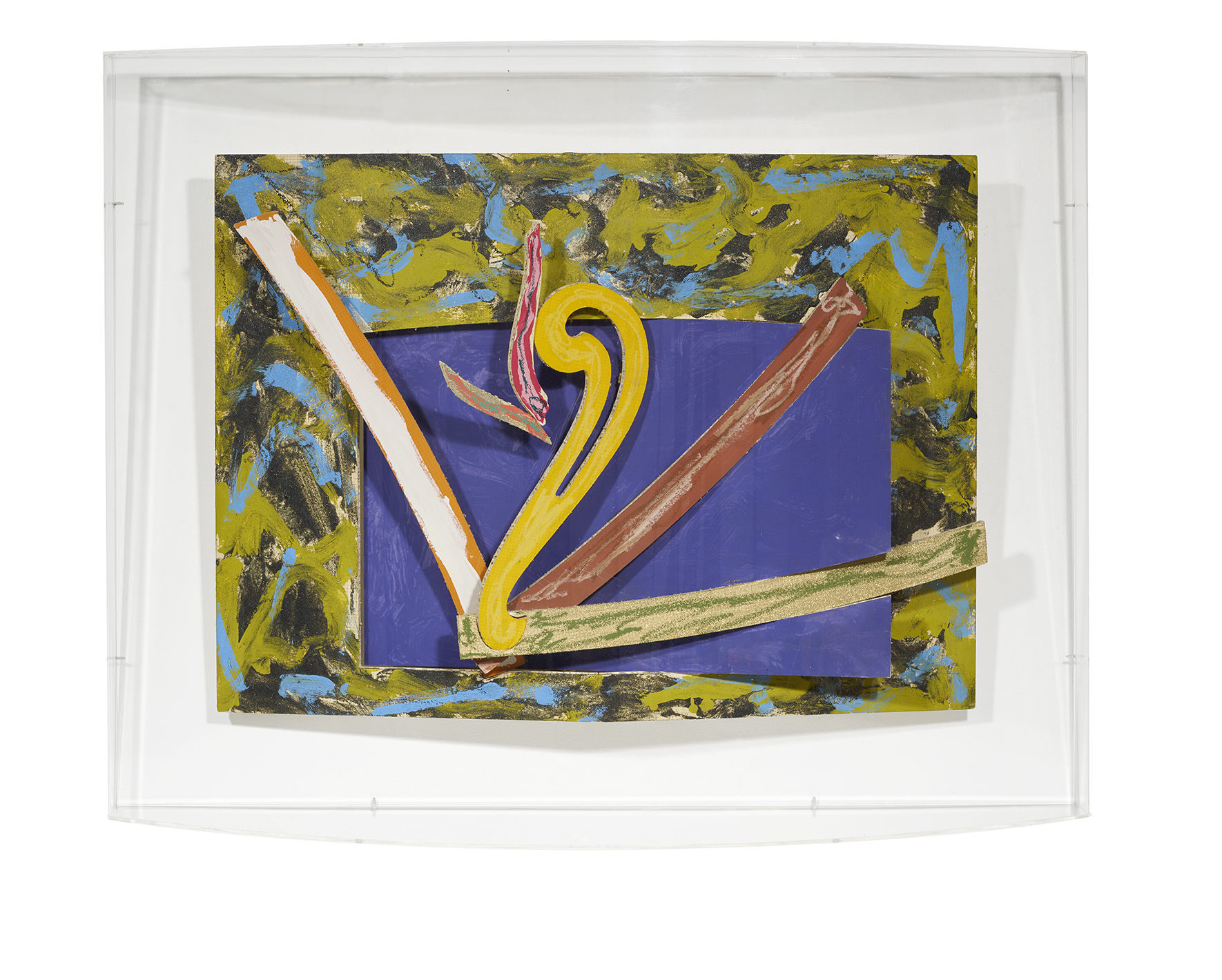Frank StellaNew Caledonian Lorikeet
1977
Mixed media on tycore board
Titled, dated and signed F.Stella on the back
21.26 x 27.95 x 4.72 in ( 54,5 x 71 x 12 cm )ZoomInquiry - New Caledonian Lorikeet, 1977
Provenance
Private Collection, Belgium
Literature
Stella 1970-1987, Paris, Musée national d'Art moderne, centre Georges Pompidou, 1988, p.23
Exhibited
"Frank Stella 1970-1987", Musée National d'Art moderne, 18 mai - 28 août 1988
Artwork's description
New Caledonian Lorikeet (1977) from the Exotic Birds series is a relief on tycore (rigid honeycomb cardboard). Like for the other works in this series, Frank Stella was inspired after his trip in Brazil, by birds on the verge of extinction, here, the New Caledonian Lorikeet. Through these works, the artist pays tribute to his friend Franck Gehry, using templates from naval and railway architecture. Thus in his conception Frank Stella's line constantly follows the curves of these rigid forms so that the hand is never completely free. These pieces on tycore panel precede the larger aluminum works from the same series.
The Exotic Birds are a complete break from Stella's earlier works. In the face of insistent and rationalist rigor of the stripe paintings, the artist proposes fantasy and improvisation; against "tight" execution, a loose and painterly handling. And against what had earlier appeared to be a suppression of illusionisme, the relief make room for an exploration of certain visual ambiguities.
To many it seemed as if these highly colored reliefs could hardly have been made by "the painter of the stripes". How to explain that the one who defined himself in 1959 by his geometry, his minimalism and the thinness of his lines, be the same one who, fifteen years later, embraces a vocabulary so luxuriant and of such a profusion of colors and dimensions.
Artist's biography
Frank Stella, born on May 12, 1936, in Malden, Massachusetts, is a major figure in American contemporary art, known primarily for his contributions to minimalism and geometric abstract art. His groundbreaking work in the 1960s redefined the possibilities of modern painting, exploring color, form, and space in a radically new way.
Stella grew up in an Italian-American family and showed early interest in art. He studied painting at Princeton University, where he was influenced by emerging American abstraction theories and practices. From the outset in the 1950s, Stella distinguished himself with a resolutely non-expressive approach to painting, favoring geometry and formal rigor over subjective gesture.
One of Stella's earliest significant series is the "Black Paintings" (1958-1960), which gained attention for its bold use of black color and simple, repetitive forms such as parallel bands and squares. Works like "Die Fahne Hoch!" (1959) marked a shift towards radical abstraction and formal reduction, anticipating the minimalist art movements that would dominate the American art scene in the years to come.
In the early 1960s, Stella expanded his exploration of form with series like "Irregular Polygons" and "Protractor Series", where complex geometric shapes overlap and intertwine in increasingly dynamic compositions. His use of color also became more intricate, with vivid juxtapositions and striking contrasts that challenged the viewer's spatial perception.
Stella is also renowned for his sculptural works, such as "Scarlet X" (1967), which utilize aluminum and other industrial materials to create abstract three-dimensional forms. These sculptures, often monumental and large-scale, reinforce his exploration of physical space and materiality in contemporary art.
Another iconic series by Stella is "The Polish Village" (1971), which marked a return to a more limited color palette and a more narrative exploration. These works combine geometric forms with graphic and textual elements, reflecting his interest in history, culture, and collective memory through an abstract aesthetic.
Over the decades, Stella continued to innovate, exploring new mediums such as printmaking and lithography, as well as diverse artistic themes. His collaborations with printers and publishers, such as the "Circuits" series (1980), demonstrate his commitment to expanding the boundaries of abstract art through different techniques and disciplines.
Frank Stella's legacy lies not only in his revolutionary works but also in his impact on the global artistic dialogue. He influenced several generations of artists with his ability to translate theoretical ideas into concrete and innovative artistic practices. Recognizing his significance, Stella has received numerous awards and has been honored with major retrospectives in prestigious institutions worldwide.
In retrospect, Frank Stella's major works, from the "Black Paintings" to his more recent series like "Cones and Pillars", attest to his dedication to formal rigor, technical innovation, and ongoing exploration of painting and sculpture possibilities within an abstract context. His work continues to inspire and challenge, solidifying his place among the great pioneers of contemporary art.
Frank Stella remains active in the art world, continuing to create and exhibit his work globally, while leaving behind a lasting and influential legacy in the history of modern and contemporary art.
